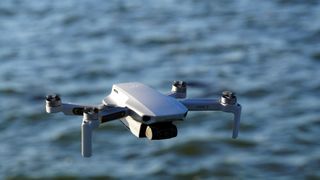When you're a hammer, everything looks like a nail; when you're a drone spotter, everything looks like a drone.
As someone who's flown more than a few drones in his lifetime and sometimes carries a foldable one in his pocket during weekend hikes so he can randomly pull it out and fly it over hills, lakes, homes, and trees, I'm a bit of a drone watcher; not to be confused with a bird watcher (I'm that, too), who keeps his eyes and ears open for the aviary kind. Come to think of it, drone spotting is a bit like that, too. Usually, I hear the high-pitched buzz, and then I cast about, scanning the skies for the tell-tale movement (hover, sprint, hover, zig-zag) and spinning rotors of a consumer-grade drone.
Like a birder, I'll call out, "Oh, look, someone's flying a drone over us." Over the years, I have seen consumer class (usually under 250 grams) drones fly over my home. I typically try to identify which DJI drone it is; maybe a DJI Mini, perhaps a Mavic or DJI Mavic Pro. Usually, it's not one of the larger Phantom Pro drones since most people are neither qualified nor allowed by the FAA to fly them over residential areas.
What's up with that?
Naturally, I've been intrigued by the explosion of east coast US drone sightings in recent weeks. In the videos (mostly unverified) I've seen on TikTok, they tend to be much larger than anything I've flown. In fact, they appear to be huge (think five or six feet across) enterprise-grade drones used by businesses for surveillance, package delivery, and feature film operations.
Where I live – in New York – and surrounding cities along the east coast of the US, drone spotting is now something of an obsession, though I haven't quite caught the bug.
During a recent crystal clear night that featured a brilliantly bright full Moon and Jupiter nearby, my offspring and I dragged our Celestron telescope outside to star gaze. As we stood shivering in the night, trying to get Jupiter's moons lined up in our scope, I started pointing out a few low-orbit satellites silently dashing by: They're usually easily identified by their speed, straight-as-an-arrow trajectory and lights that blink at regular intervals. It never occurred to me to suspect them of being drones. Perhaps I know better, or maybe, unlike others, I'm not looking for drones in the night sky.
Look, I'm not saying there aren't drones flying over the East Coast of the US. They may be, but I don't think it's an invasion. Here are some ideas about what's going on:
- There was a larger drone test conducted either by the local or federal government or a company that wanted to see how well a delivery fleet operated at night. Since 2021, the FAA has authorized some drone night flights, though the drones still have to remain at elevations under 400 feet. That may account for why these drones have been so visible. They're larger and cannot break the rules by flying in air space reserved for airplanes.
- After that initial flight (and maybe a few subsequent ones), undiscerning eyes started to think that any light in the sky that they could not identify was also a drone. Drones of the size most people claim they're seeing, by the way, are not easy to fly, and night flights would require even more expertise.
- Also, for those worrying that these drones are coming from foreign enemies, it's worth remembering that unless they're military drones, they're not flying thousands or even hundreds of miles to reach US shores. I also have to wonder what usable information "spy drones" would get from flying over the suburbs at night.
- Amateur drone operators are opportunistically taking more night flights than before, hoping that people will spot their fliers and add them to these worrisome reports. Non-pros taking nighttime flights is concerning, but these drones use GPS and not sight to navigate and can go out on a programmed flight and return home on their own without much intervention by amateur pilots.
Faster action will help
Now, I tend to agree that the government (local and federal) has moved too slowly to address the "drone invasion" (they've finally agreed to send in special drone-detecting technology), but I also think the FAA has been too lax about drone registration and tracking. Essentially, anything that takes off in public airspace should instantly become a tracked dot on local flight tracking systems. FWIW, if you ever found my lost drone, you'd open up the battery compartment to find my drone pilot registration number.
All this aside, I'm almost certain that the majority of drones people think they're seeing are not. They're still planes, helicopters, and satellites. However, until the US government responds effectively to consumer concerns, the drone hysteria will grow, people will start shooting at these drones, and then someone will probably really get hurt.
Don't be a hammer looking for a nail.










 English (US) ·
English (US) ·